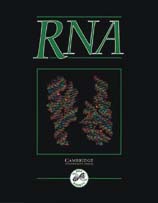Crossref Citations
This article has been cited by the following publications. This list is generated based on data provided by
Crossref.
Johnson, Mark A.
Pérez-Amador, Miguel A.
Lidder, Preetmoninder
and
Green, Pamela J.
2000.
Mutants of
Arabidopsis
defective in a sequence-specific mRNA degradation pathway
.
Proceedings of the National Academy of Sciences,
Vol. 97,
Issue. 25,
p.
13991.
Howard, Michael T.
Shirts, Brian H.
Petros, Lorin M.
Flanigan, Kevin M.
Gesteland, Raymond F.
and
Atkins, John F.
2000.
Sequence specificity of aminoglycoside-induced stop codon readthrough: Potential implications for treatment of Duchenne muscular dystrophy.
Annals of Neurology,
Vol. 48,
Issue. 2,
p.
164.
Narry Kim, V.
and
Dreyfuss, Gideon
2001.
Nuclear mRNA Binding Proteins Couple Pre-mRNA Splicing and Post-splicing Events.
Molecules and Cells,
Vol. 12,
Issue. 1,
p.
1.
Serin, Guillaume
Gersappe, Anand
Black, Jennifer D.
Aronoff, Rachel
and
Maquat, Lynne E.
2001.
Identification and Characterization of Human Orthologues to Saccharomyces cerevisiae Upf2 Protein and Upf3 Protein (Caenorhabditis elegans SMG-4).
Molecular and Cellular Biology,
Vol. 21,
Issue. 1,
p.
209.
Hir, Hervé Le
Gatfield, David
Braun, Isabelle C
Forler, Daniel
and
Izaurralde, Elisa
2001.
The protein Mago provides a link between splicing and mRNA localization.
EMBO reports,
Vol. 2,
Issue. 12,
p.
1119.
González, Carlos I
Bhattacharya, Anirban
Wang, Weirong
and
Peltz, Stuart W
2001.
Nonsense-mediated mRNA decay in Saccharomyces cerevisiae.
Gene,
Vol. 274,
Issue. 1-2,
p.
15.
Thomas, H.
Badenberg, B.
Bulman, M.
Lemm, I.
Lausen, J.
Kind, L.
Roosen, S.
Ellard, S.
Hattersley, A. T.
and
Ryffel, G. U.
2002.
Evidence for Haploinsufficiency of the Human HNF1α Gene Revealed by Functional Characterization of MODY3-Associated Mutations.
Biological Chemistry,
Vol. 383,
Issue. 11,
Bornstein, Paul
Walsh, Vanessa
Tullis, Jennifer
Stainbrook, Emily
Bateman, John F.
and
Hormuzdi, Sheriar G.
2002.
The Globular Domain of the Proα1(I) N-Propeptide Is Not Required for Secretion, Processing by Procollagen N-Proteinase, or Fibrillogenesis of Type I Collagen in Mice.
Journal of Biological Chemistry,
Vol. 277,
Issue. 4,
p.
2605.
Wang, Jun
Gudikote, Jayanthi P
Olivas, O Renee
and
Wilkinson, Miles F
2002.
Boundary‐independent polar nonsense‐mediated decay.
EMBO reports,
Vol. 3,
Issue. 3,
p.
274.
Shirley, Renee L
Ford, Amanda S
Richards, M Rachel
Albertini, Markus
and
Culbertson, Michael R
2002.
Nuclear Import of Upf3p Is Mediated by Importin-α/-β and Export to the Cytoplasm Is Required for a Functional Nonsense-Mediated mRNA Decay Pathway in Yeast.
Genetics,
Vol. 161,
Issue. 4,
p.
1465.
Comeron, Josep M
2004.
Selective and Mutational Patterns Associated With Gene Expression in Humans.
Genetics,
Vol. 167,
Issue. 3,
p.
1293.
Ionov, Yurij
Nowak, Norma
Perucho, Manuel
Markowitz, Sanford
and
Cowell, John K
2004.
Manipulation of nonsense mediated decay identifies gene mutations in colon cancer Cells with microsatellite instability.
Oncogene,
Vol. 23,
Issue. 3,
p.
639.
Slesina, Marco
Inman, Elisabeth M.
Rome, Leonard H.
and
Volknandt, Walter
2005.
Nuclear localization of the major vault protein in U373 cells.
Cell and Tissue Research,
Vol. 321,
Issue. 1,
p.
97.
Khajavi, Mehrdad
Inoue, Ken
Wiszniewski, Wojciech
Ohyama, Tomoko
Snipes, G. Jackson
and
Lupski, James R.
2005.
Curcumin Treatment Abrogates Endoplasmic Reticulum Retention and Aggregation-Induced Apoptosis Associated with Neuropathy-Causing Myelin Protein Zero–Truncating Mutants.
The American Journal of Human Genetics,
Vol. 77,
Issue. 5,
p.
841.
Slesina, Marco
Inman, Elisabeth M.
Moore, Ann E.
Goldhaber, Joshua I.
Rome, Leonard H.
and
Volknandt, Walter
2006.
Movement of vault particles visualized by GFP-tagged major vault protein.
Cell and Tissue Research,
Vol. 324,
Issue. 3,
p.
403.
Amrani, Nadia
Sachs, Matthew S.
and
Jacobson, Allan
2006.
Early nonsense: mRNA decay solves a translational problem.
Nature Reviews Molecular Cell Biology,
Vol. 7,
Issue. 6,
p.
415.
Bloethner, Sandra
Mould, Arne
Stark, Mitchell
and
Hayward, Nicholas K.
2008.
Identification of ARHGEF17, DENND2D, FGFR3, and RB1 mutations in melanoma by inhibition of nonsense‐mediated mRNA decay.
Genes, Chromosomes and Cancer,
Vol. 47,
Issue. 12,
p.
1076.
Sun, Guihua
Li, Haitang
and
Rossi, John J.
2010.
Sequence context outside the target region influences the effectiveness of miR-223 target sites in the RhoB 3′UTR.
Nucleic Acids Research,
Vol. 38,
Issue. 1,
p.
239.
Kervestin, Stephanie
and
Jacobson, Allan
2012.
NMD: a multifaceted response to premature translational termination.
Nature Reviews Molecular Cell Biology,
Vol. 13,
Issue. 11,
p.
700.
Min, Ei Ei
Roy, Bijoyita
Amrani, Nadia
He, Feng
and
Jacobson, Allan
2013.
Yeast Upf1 CH domain interacts with Rps26 of the 40S ribosomal subunit.
RNA,
Vol. 19,
Issue. 8,
p.
1105.

